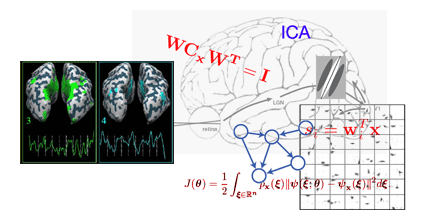
- Group leaders: professor Aapo Hyvärinen and Patrik Hoyer
- Group homepage: http://hiit.fi/neuroinf

The mission of the Neuroinformatics team is to develop statistical data analysis methods, with the particular applications of neuroscience in mind. In some areas of neuroscience, such as brain imaging, measurement devices provide huge amounts of data and new methods are needed to analyze the data. On the other hand, modelling perception can be approached from a Bayesian viewpoint, as probabilistic modelling of typical stimuli. General-purpose statistical learning methods are naturally developed at the same time.
The Neuroinformatics team has no subgroups.
Research activities 2008-2010
Our research on computational neuroscience culminated in the publications of the book "Natural Image Statistics: A Probabilistic Approach to Early Computational Vision". This is the first book to give a comprehensive overview of this very modern approach to visual neuroscience. In particular, it is a specific example of the Bayesian approach to modelling of perception and intelligence more generally.
In our project on brain imaging data analysis we concentrated on developing advanced methods for separating sources in brain activity. Different variants of independent component analysis have been developed. In brain imaging, the data is rather different from a basic ICA setting in the sense that we have data from several subjects. Combining information from many subjects is challenging but it is also useful because it allows for an assessement of the reliability of the components.
We have also been actively working on general-purpose data analysis tools for discovering potential causal relationships (in the form of directed graphical models) from data. Our group introduced a basic model using linear non-Gaussian directed acyclic graph in 2006, and we have recently extended the model in a number of practically important directions, in particular with regards to handling hidden variables, time structure, and non-linearities. Applications to neuroimaging data, as well as in econometrics, are currently investigated.
Recently developed models of natural image statistics are highly complex and their estimation often requires new developments in estimation theory. Based on our initial work on score matching in 2005, we have now developed a new approach for estimating statistical models which are not properly normalized (i.e. the partition function is not known analytically and it is very difficult to compute). This new method is based on the intuitive idea of learning a classifier to distinguish between natural images and noise.